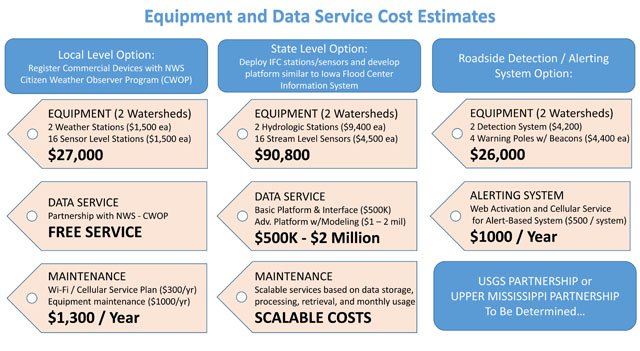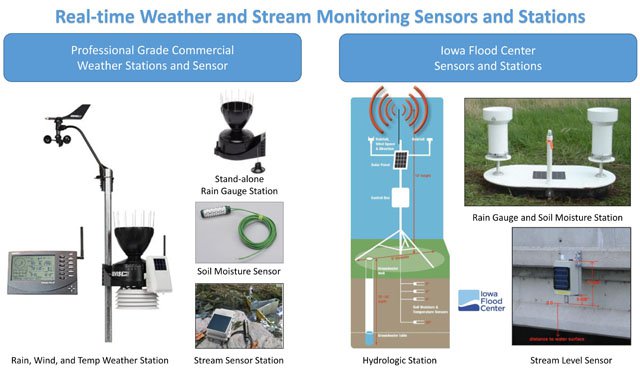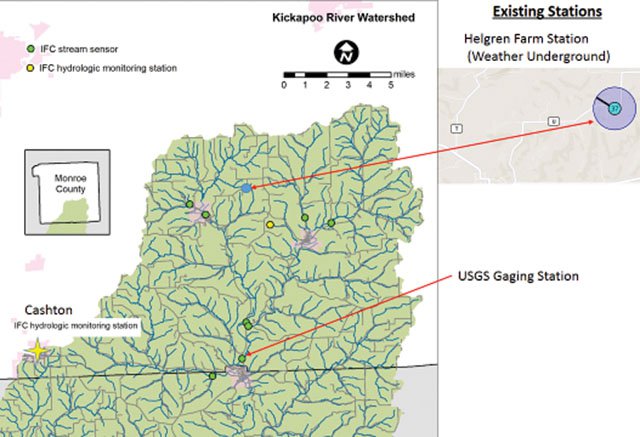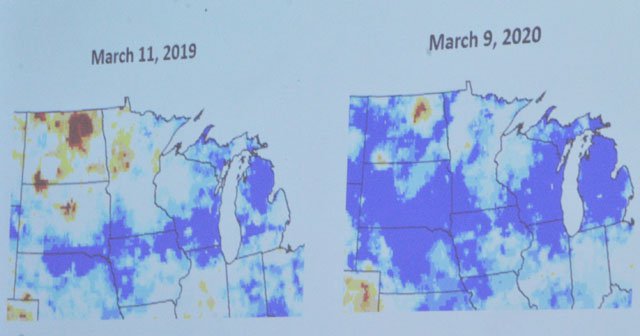DRIFTLESS - Monroe County is leading the charge in the Driftless Area regarding development of a stream monitoring and flood forecasting system. At their meeting in Sparta on Wednesday, March 11, members of the county’s Climate Change Task Force heard from members of the county board present that they believed the County Board of Supervisors would likely vote to fully fund purchase and installation of stream sensors, hydrologic monitoring stations, and roadside alerts proposed by the committee as the ‘local option.’




That local option, a $55,300 package, calls for installation of two weather stations; 16 stream sensors; two roadside detectors; and four warning poles with beacons for known problem areas on roads in times of flooding. The data for this local option would be housed free of charge with the National Weather Service (NWS) in LaCrosse. Yearly maintenance is estimated at $1,300, and set up of an alerting system at $1,000 per year. These devices would be deployed in Monroe County in the Little LaCrosse and Kickapoo River watersheds.


One of the proposed sensors would be placed in Cashton, which sits at the headwaters of the Kickapoo River, West Fork Kickapoo River, Coon Creek and Little LaCrosse River watersheds. This is the area where the super storm that set up the breach of five flood control dams and historic flooding of 2018 vented its wrath.
The meeting was once again attended by representatives from Congressman Ron Kind, and Senators Tammy Baldwin and Ron Johnson’s offices. In addition, DNR Secretary's Director for the West Central Region Dan Baumann attended, as did Vernon County Board Supervisor Mary Henry and Vernon County Conservationist Ben Wojahn. Natural Resource Board member and Director of the Kickapoo Valley Reserve Marcy West was there, as well as a representative from the Mississippi River Regional Planning Commission (MRRPC). Robert Nigh of the Wisconsin Farm Bureau Board and the Governor’s Climate Change Task Force also attended the meeting.

Flood outlook
Attendees at the meeting were treated to a preview of the NWS LaCrosse’s third ‘Spring Flood Outlook’ one day before its release to the public on Thursday, March 12. NWS Service Hydrologist John Wetenkamp spoke with members of the task force, and delivered some cautious good news.
“Our area has experienced an ideal thaw this spring, with warm days and cold nights, slowing down the melt,” Wetenkamp said. “This means that the forecast for flooding on the Mississippi River is now considered minor, as is the forecast for the Kickapoo River.”

Wetenkamp emphasized, however, that risk factors for flooding such as saturated soils and high steam base flows in the tributaries, continue to be a cause for concern. Although snow is mainly melted in the southern part of the Upper Mississippi Watershed, and the frost is also leaving the soil, there is still between 1-6 inches of liquid in the remaining snow cover in the north.
“It will basically all boil down to how the spring precipitation shapes up,” Wetenkamp said. “For March 18-24, the forecast is for precipitation is below normal, and right now, for March through May, the forecast is slightly elevated for above normal precipitation.”

Collaboration
Vernon County Board Supervisor Mary Henry raised the question about whether multiple counties in a watershed like the Kickapoo River could collaborate in a flooding monitoring and warning system.
DNR’s Dan Baumann stated that it is possible, if Monroe, Vernon, Richland and Crawford counties were to come together around a water quantity and quality monitoring effort in the Kickapoo River Watershed, it is possible that DNR and other sources of funding could be accessed.
“The bigger the watershed being addressed, the better your chances of funding would be,” Baumann said. “This is particularly true for watersheds that are already listed as impaired or under a Total Daily Maximum Load plan, and your chances would be better if the system were set up to monitor both in times of flooding but also in times where it is not flooding.”
In a follow up conversation after the meeting, Baumann told the Independent-Scoutthat “our rivers planning and protection funds as well as our non point source dollars are usually the best fit. There are many instances though where we work with local governments (Counties, Cities, Villages and Towns) to partner on activities that leverage an array of funding sources. One example would be work on a trout stream that involves habitat improvement, water quality monitoring and non-point source pollution reduction. That type of project could include County Land and Water dollars, Trout stamp funds, EPA water quality dollars and non-profit money like from Trout Unlimited. Projects that include a comprehensive approach and a number of partners, score higher on most funding sources.”
Baumann also pointed out that the Governor’s ‘Rural Health and Prosperity’ initiative would likely cover investments designed to increase a community’s flood resilience. Areas like the Kickapoo River Valley have suffered adverse economic impacts from frequent flooding.

Monroe County Land Use Planner Roxie Anderson reported that she had met recently with representatives of MRRPC about funding to address the impact that flooding has on local economies.
“In applying for the funding for the Kickapoo River, a letter signed by all four county board chairmen could be very impactful,” Baumann said. “Right now, the timing could be good.”
Robert Nigh shared that he thinks the Driftless Area needs to find ways to work together on a watershed basis. He noted that in Vernon County, in addition to the Kickapoo River, attention was also needed in the Coon Creek and Bad Axe River watersheds. Coon Creek would require a collaboration between LaCrosse, Monroe and Vernon counties.
Vernon County Conservationist Ben Wojahn told the group that he has been working to form a three-county watershed authority for the Coon Creek Watershed. He said that a successful effort in that watershed could provide a blueprint for other watersheds.
Segregated fund
The Monroe County Climate Change Task Force has approved a resolution creating a segregated fund to which contributions from businesses and individuals can be donated. These funds would only be available to finance task force initiatives. While Monroe County cannot solicit funding for a monitoring and warning system from the private sector, through setting up this account, they would be able to accept them.
The resolution has already passed unanimously in the county’s Natural Resources Committee. It heads next to the Finance Committee, and from there, to the Monroe County Board later in March.
Marcy West sits on the board of an old non-profit in the Kickapoo Valley – the Kickapoo Valley Association, established in 1965. West said that her fellow board member, Emily Rozeske, is making a pamphlet that can be used to solicit donations towards building a monitoring and warning system in the Kickapoo Valley. That non-profit could accept tax-deductible donations, which could then be donated to counties that have set up a segregated account for the purpose.
“We are seeking membership on the KVA Board from Richland and Crawford counties,” West said. “If we were to start accepting donations for this cause, we would need explicit agreement about how the funds are to be used.”
Marcy West can be reached at the Kickapoo Valley Reserve, 608-625-2963, or by e-mail at marcy.west@krm.state.wi.us.
The next meeting of the Monroe County Climate Change Task Force will take place on Wednesday, April 8, from 2:30-4:30 p.m., at the Monroe County Courthouse in Sparta.
In addition, the Governor’s Climate Change Task Force will hold a meeting at the Organic Valley building in Cashton on Thursday, May 21, time TBD.





